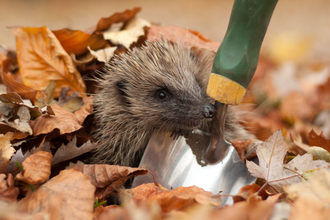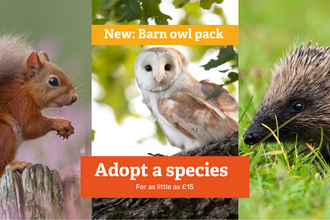Our beloved hedgehogs are thought to be one of the oldest mammals on Earth. This speaks to their resilience and great evolutionary design. Shakespeare even mentioned these snuffly creatures fondly in his works. Sadly, they are on the IUCN's 'red list', meaning that their numbers are in decline, even though they are legally protected under Schedule 6 of the Wildlife and Countryside Act of 1981.
It is our duty to help and protect these helpful hogs, so read on to see how your small actions can make a huge difference to our prickly visitors.
If you need urgent help for an injured or sick hedgehog, call The British Hedgehog Preservation Society for first aid advice on:
01584 890 801
European hedgehog in the garden (Erinaceus europaeus)
Photo by Gillian Day
Log your hog sighting as a Hedgehog hotspot
Have you seen a hedgehog, or been lucky enough to have one stay in your garden? By recording your sighting, you add vital information to our reporting database which helps us focus our conservation efforts more efficiently on hedgehog hot-spots or not-spots.
Log your hog encounter with us here: Hedgehog Hotspots
It takes 3 minutes to report your hedgehog sighting, with no sign-up necessary. If you have not seen a hedgehog this year, or have noticed a distinct absence of hedgehogs where you would usually spot some, please also record this as it builds a more accurate picture of their changing behaviours and populations. Thank you for your contribution to this citizen science project- and for helping a hog!

Photo by Tom Marshall
There’s a hedgehog in my garden! What should I do?
Hedgehogs are nocturnal, and most active at night. If you see one snuffling about in the daytime, it could mean that they are injured, unwell, or simply searching for food which they haven’t managed to find during the night.
If your hedgehog seems happy and well, you can leave a clean, shallow dish of water out for it, along with a dish of food. Suitable foods for hedgehogs are outlined in the What do hedgehogs eat section below
Creating a hedgehog home for them to rest in the daytime or hibernate all winter long is one of the best things you can do to help our prickly population of garden visitors. Allowing hedgehog holes and hallways to and from your garden, along with escape routes from ponds, are all simple actions which give a helping hand to hedgehogs.

A rescued hedgehog being handled carefully
What to do if you see an injured hedgehog
If a hedgehog is obviously injured, seems ‘drunk’, surrounded by flies or is ‘sunbathing’, it needs urgent first aid. Luckily there are many places that can provide this. If you’ve found a hedgehog injured or in danger, click here to find your nearest rescue centre or use our menu of Wildlife Rescues in Lancashire at the bottom of our injured wildlife guide
If you cannot find a rescue centre via this directory, please call the British Hedgehog Society who can advise on the best course of action.
Signs that a hedgehog is unwell or in need of first aid
- Appearing wobbly or unstable when walking
- Obvious injury or wounded
- Out in the sunshine or lethargic i.e. not moving much
- A hoglet out by itself. Even if it is not ‘squawking’, a baby hedgehog is vulnerable and shouldn’t be alone
A rescued hoglet resting comfortably in a box
Photo by Gillian Day
Further first aid and handling a hedgehog advice can be found from The British Hedgehog Preservation Society: Found a hedgehog?
And a helpful step-by-step instruction guide from The Lancashire Hedgehog Care Trust
Some people are reluctant to approach hedgehogs because of the idea that they are covered in fleas and other parasites. This is not strictly true, as they practice something called ‘self-anointing’, whereby they cover themselves with a fine layer of their own saliva which is anti-bacterial, not only protecting them from parasitic insects and fleas, but also making them taste disgusting to any potential predators. However, you should always wear gloves and cover your arms when handling a hedgehog.
What do hedgehogs eat?
Hedgehogs are omnivores, meaning they have a varied diet which gives them the best chance of survival. Treats found in your garden will include slugs and snails and other invertebrates, worms and insects, frogs and fish, and even baby mice and small snakes! Hedgehogs are known to eat small birds if they need to. They are hogs by name, and hogs by nature - they need to eat a lot!
A hedgehog feeding from a dish of food
Photo by Gillian Day
Is it okay to feed hedgehogs? What can I give them to eat?
Yes! During winter months, hedgehogs need a boost to their available food supply. Hedgehogs like cat food, and can also eat fruit and vegetables, so it is safe to leave out apples, raw carrots and some berries. See a list of toxic foods below. Some pet shops also sell specially developed dry hedgehog pellets, or wet hedgehog food, which takes the guesswork out of whether you are feeding your garden visitor the right things. Be sure to leave a dish of water out for the hedgehog, especially when giving dry food, or during a dry season, and keep refreshing it if it freezes over in winter.

Photo by Tom Marshall
What should I never feed a hedgehog? Foods that are toxic to hedgehogs...
In terms of food from your own kitchen that hedgehogs cannot tolerate, the main toxic foods that you should never leave out for a hedgehog are:
- Bread
- Grapes
- Raisins
- Tomato
- Pineapple
- Avocado
- Citrus fruits, like limes, lemons, grapefruit and oranges
- Dairy- it is a myth that hedgehogs like a saucer of milk!
- Honey
- Tea-tree oil
- Nuts can also be a choking hazard as they get stuck to the roof of their mouth
- Pumpkin
- Poisoned slugs and snails
Two young hoglets feeding at night-time
Photo by Gillian Day
Are hedgehogs nocturnal?
Yes, they are mostly active at night. A hedgehog shouldn’t usually be pottering around in the daytime as it is against their natural rhythm and routine. If you are concerned about a hedgehog that is active all day, particularly in bright sunshine, or not moving very much, report them to a rescue centre which will advise you what to do.
However, seeing a hedgehog in the day isn’t always a sure sign that there is something wrong with them. Sometimes it means that they have not gathered enough food from the previous night, they may be searching for a new nest to rest in because they have been displaced from elsewhere or are foraging for food for their hungry young. If the hedgehog seems otherwise healthy and happy, it could be one of these reasons and does not need urgent care.

Hedgehog curled up in Autumn leaves
Photo by Tom Marshall
What are a hedgehog's hibernation behaviours?
Hedgehogs typically go into hibernation around November and emerge around March or April, but this is weather dependent. Hedgehogs need to be a healthy weight to go into hibernation to survive the winter. They have been known to feed right into December before finding a place to curl up for the winter months.
Hibernation is the process of ‘torpor’, where a mammal drops its body temperature and slows down its metabolic rate to match its surroundings and expend far less energy. If you have provided a safe haven and hedgehog house for them, they will choose your spot to spend their hibernation period.

Resources and activities can be explored on www.wildlifewatch.org.uk
How to build a hedgehog home
Fortunately, there are many ways in which you can make your garden or outdoor space a haven for hogs. You can buy ready-made hog houses or take the D.I.Y route. Learn how to build a hedgehog home here.

Photo by Tom Marshall
Other things you can do to help hedgehogs in your garden
In addition to creating a lovely place to rest, hibernate and nest for our little hogs, the simplest thing we can all get into the habit of doing over the autumn season is checking our bonfire wood piles BEFORE setting it ablaze. Either build your bonfire on the day you intend to burn it, or do a thorough check to see if a prickly visitor hasn’t taken a nap in your cosy wood and leaf-litter pile. For more details on checking your wood and leaf-litter piles for hedgehogs and other mammals, visit this page.
As much as we love celebrating the autumn season with pumpkins on our doorsteps and in our back gardens, pumpkins are poisonous to hedgehogs, and a hungry hog may try and nibble your carved creation. To prevent this, please bring your pumpkins in for the night, and dispose of them as soon as they begin to rot.

Hedgehogs rely on urban surroundings more than ever
Photo by Tom Marshall
Hedgehog highways, holes and hallways
Something that all garden lovers can do is to create hedgehog hallways. This is simply a hole in the bottom of your fence panels, or an outlet at your garden perimeter, which allows hedgehogs to travel through the neighbourhood without the barriers of climbing and potentially falling into ponds, or finding alternative routes which lead them onto roads. It is well known how far a hog can travel throughout the night- up to two miles!- so creating passageways and access points between gardens is the easiest way to ensure that they do not become road-kill and can freely roam between gardens for the best access to find food and rest. To create a hedgehog highway and give them room to roam, have a look at our quick, easy guide - how to create a hedgehog hole.

Two hedgehogs. The collective term for hedgehogs is an 'array'
Photo by Jon Hawkins
Investigate your invertebrates
The greatest poison to hedgehogs in our domestic gardens is slug pellets and pesticides. The use of these products also means that an unsuspecting hedgehog may come across a poisoned slug or snail and eat it, dying from secondary poisoning. Natural alternatives to controlling the slug and snail population in your garden and protecting your beautiful plants is to sprinkle eggshells and coffee grounds onto your pots and flower beds. Not only is this an effective and cheap deterrent, but it also nourishes the soil. Garden centres often sell plant pots with a rough, grainy strip around the top of the pot to further prevent slug and snails from munching on your greenery.
Pond Pedestals
It surprises most people to learn that these shuffling, snuffling creatures with short stubby legs are adept climbers. It is a useful survival mechanism, but not the most efficient way to get around. Whether you have a raised or sunken pond, a rain barrel or uncovered hot tub in the summer, be sure to include access for a misadventuring hedgehog to escape. This could be a wooden plank, bricks, an upturned plant pot or any raised platform which will prevent a hedgehog from getting trapped.

Photo by Jon Hawkins
Useful organisations and further advice
Liked this page and love hedgehogs? Download your free Help a Hog guide from here
All organisation, helplines and authorities on hedgehog advice mentioned in this guide are provided below:
- The British Hedgehog Preservation Society
- Nearest Rescue Centre in Lancashire Directory
- Lancashire Hedgehog Care Trust
- Hedgehog Street
- Our friends at Chorley Hedgehog Rescue
- Log your Hog sighting with Lancashire Wildlife Trust
- Frequently Asked Questions
- Injured Wildlife Rescue Centre guide
- If you are a farm or landowner, or living in a rural area, this free guide provides tips on protecting and encouraging hedgehogs: How to help rural hedgehogs: free guide for farmers



